Nokia Lumia 630 Review
by Brett Howse on July 22, 2014 8:00 AM EST- Posted in
- Smartphones
- Microsoft
- Nokia
- Mobile
- windows phone
Camera
Budget phones often have budget cameras, and the Lumia 630 is no exception. The camera module is a 5 MP 1/4” design. This means the pixels are 1.4 µm. It is an autofocus design, but lacks any sort of flash assist. I don’t really like the flash of most smartphones anyway, since the LED often isn’t bright enough to really illuminate the scene, and instead blows out the color accuracy of whatever you are trying to capture. However when you are working with a device with a 1/4” sensor, you are going to need a flash for any sort of low light photography so it’s absence is certainly missed here. I also quite often use the LED flash as a flashlight, so it was doubly missed.
To measure camera performance, we’ll put it through several test scenes and compare it to other devices. We’ll start with the ISO 12233 test chart, and look specifically at the sagittal and tangential lines to see how well the camera can capture fine detail.
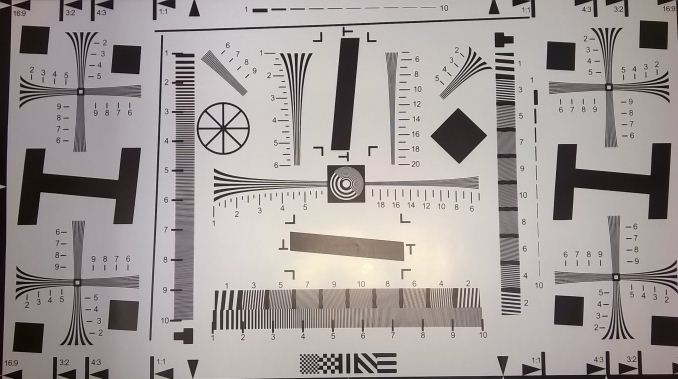 ISO 12233 Test Chart captured by Nokia Lumia 630
ISO 12233 Test Chart captured by Nokia Lumia 630
The Lumia 630, unsurprisingly, does a poor job of resolving fine detail. 5 MP isn’t a lot to work with, and with such a small sensor size it really struggles to capture enough light. The gallery below will allow you to compare it to other devices.
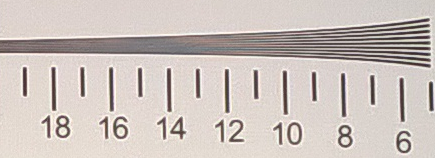
Once cropped, we can really see the shortcomings of the camera system. A common theme that I found while using the phone is that it does a reasonable job capturing a scene, but any sort of cropping of the scene later will result in an unusable image.
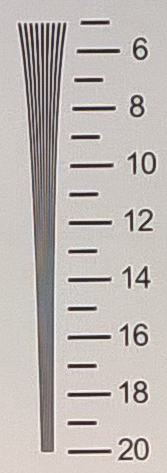
The story is the same for the tangential crop. Once zoomed in, all detail is lost. The only good news is that the 630 appears to use the same camera module as the 520 and 620, so there shouldn’t be a regression here from last year’s models.
Lab Scenes
To get a feel for how the Lumia 630 can shoot pictures under a controlled environment, we have the following sample photos comparing it to the Lumia 1020. I also included the high resolution photos from the 1020 just to see how it does pixel binning to improve the image quality of the low resolution shots. These shots were all taken with the cameras set to their default automatic modes, and the Lumia 630 defaults to 16:9 where as the Lumia 1020 defaults to 4:3 photos.
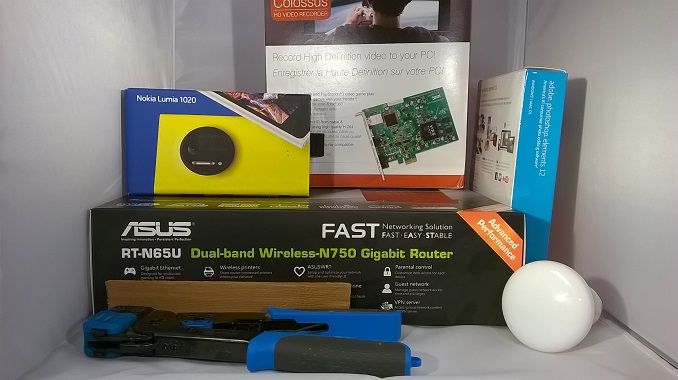
In the well lit controlled photos, the Lumia 630 does very well. It has good white balance, and the detail is actually pretty good. The white balance is better than the Lumia 1020 in this case, which historically has struggled with white balance in certain scenarios. Next up, we'll test both in a low light controlled scenario. You can use the gallery below to sample full resolution images from this test.
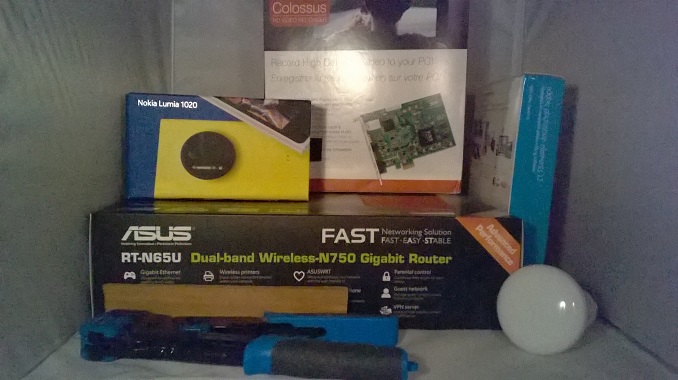
For the low light shots, the ambient light is dropped to 5 lux. Unsurprisingly, with such a small sensor size the Lumia 630 really struggles to capture enough light to properly portray the scene. The picture has a lot of noise in it. This is why a flash is so important on a phone such as this, as it makes shooting any sort of dim scene very difficult. LED flashes often blow out the shot, but at least they make the shot possible. The Lumia 1020, with its 1/1.5" sensor absolutely trounces the 630 in this test. I also included the high resolution shots for the 1020 in this test just to see the pixel binning in action. The high resolution shot actually comes across with slightly less pop than the low resolution image, even though both are very good. It's especially noticeable on the white text on the router box. You can use the gallery below to sample full resolution images from this test.
Outdoor Scenes (Night)
Moving away from controlled scenes to outdoor scenes, we can see how the Lumia 630 fares under real world conditions. First up, we’ll check out its low light performance with a picture of a park bench, lit by a nearby path light.

Going into the review, my assumption was that the newer ISP of the Snapdragon 400 SoC would result in slightly better shots than the outgoing 620, but that wasn’t the case. Both devices struggled with the low light shots, but the 620 was able to achieve a better focus lock before taking a picture. The 630 did take pictures faster, but the results aren’t great in low light.

Next up is the picture of a Supermarket sign at night. Here we see similar results, with the Lumia 620 having a better white balance and better overall shot than the 620. The 620 actually has better white balance than even the Lumia 1020 in this comparison, even though the 1020 has a clearer result.
Outdoor Scenes (Daylight)
For the daylight pictures, the story changed. With enough light, the Lumia 630 can take some excellent pictures. It did have a tendency to oversaturate the images slightly, but generally the pictures were quite good.

This photo gives a good example of the oversaturation, with the Lumia 630 coming in a bit too dark for the building. The Lumia 620 undersaturated the image a bit here.
This crop compares all three photos of the flower, and demonstrates that even with sufficient light, once you zoom in on a photo with the Lumia 630, it results in a blurry image much like the Lumia 620. Overall, for daylight shots, the Lumia 630 actually does surprisingly well assuming you don’t want to zoom in on the results. Some of the pictures were oversaturated, but generally the white balance was good, and brightness and detail were both ok for a 5 MP result.
Capture Latency
The arrival of a new ISP has really helped with the speed of the camera. Both focus latency and shot latency are very good, and generally much improved over the prior generation of devices. There are no fancy rangefinders, so we’re not going to break any records, but it’s still a good result.
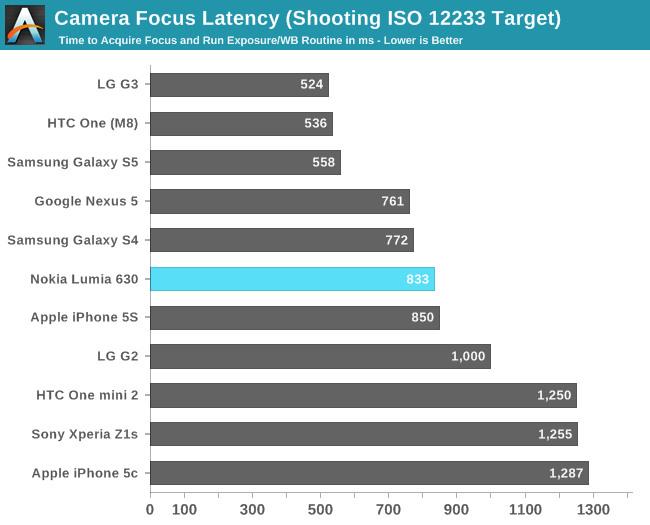
With a 833 ms focus capture, you can grab focus pretty quickly. While not up there with today’s flagship devices where focus latency seems to be a competition, it still comes in better than other devices costing much more.
Once you have focus lock, the next step is of course to take the photograph, and for that we analyze the time in between each capture.
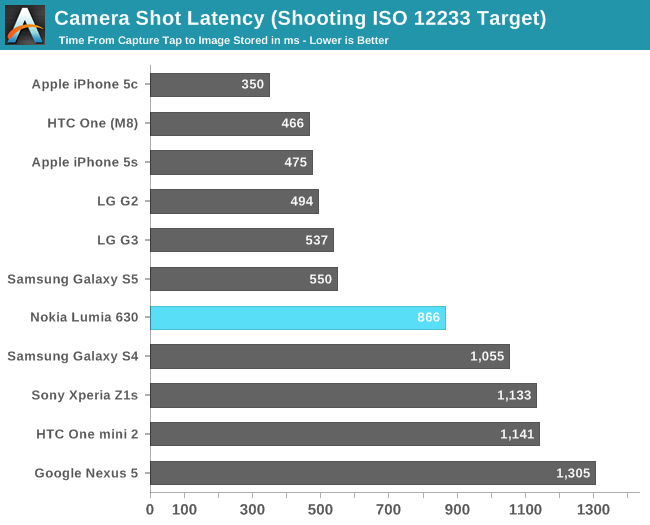
The camera latency is slightly longer than most of today’s flagship devices but it still comes in at a reasonable 866 ms. For a device at this price point, that’s a good result.
For total Camera Latency, we add the previous numbers together and compare total time to capture an image.
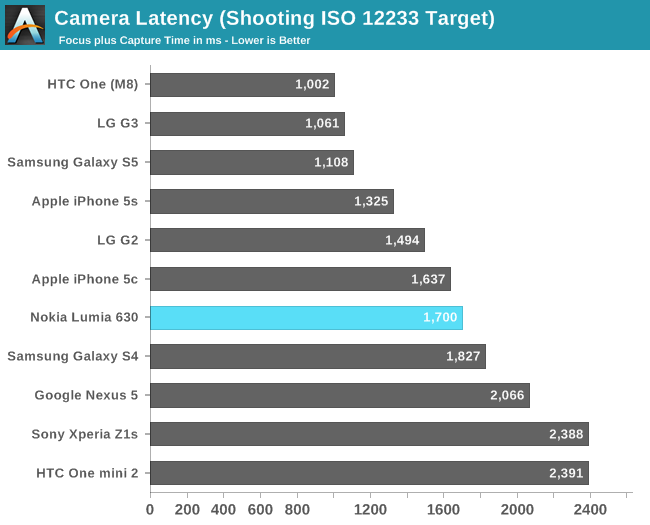
With an average focus lock and an average capture time, the Lumia 630 falls in to the middle of the pack, which is a good result for a device in this price range.
Video
The Lumia 630 is limited in what it can shoot for video. There are no options to change the resolution or frame rate at all on this device, so you are stuck with 720p30 video. With such a small sensor both in terms of size and pixels, this is probably all you can expect from the device even though the ISP can handle 1080p video.
The video quality is not exceptional, with a lot of detail missing. Being a $160 phone, it of course lacks any sort of optical image stabilization.


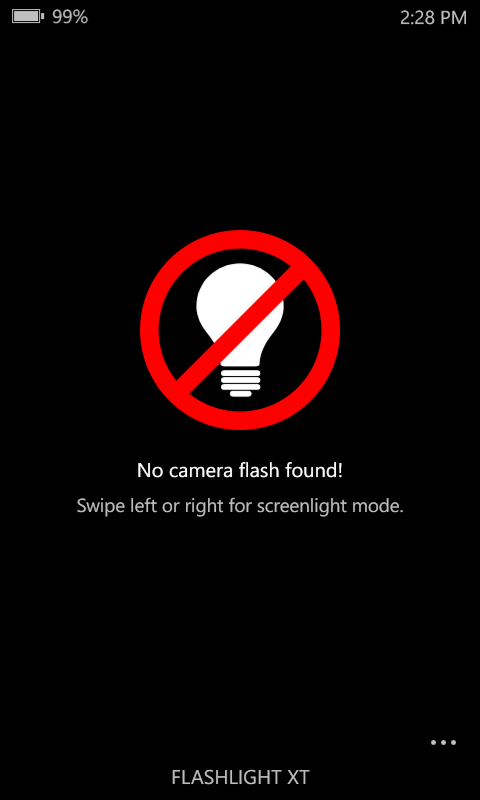































































83 Comments
View All Comments
kspirit - Tuesday, July 22, 2014 - link
Incredibly detailed and excellent as usual. Thanks for all the info. I'm glad you clarified why the 930 doesn't have Glance. It confused me, because I thought it was something MS was killing off with WP8.1. Good to know that's not the case.kspirit - Tuesday, July 22, 2014 - link
Another thing I'd like to add is that the 630's display is not "real" ClearBlack. I have seen and owned devices with those, and my father has a 630, and this is most certainly NOT a CBD. It's marketed as such but there is no polarizer.DanNeely - Tuesday, July 22, 2014 - link
"But again the storage of only 8 GB is no problem at all due to the included microSD card being able to add another 128 GB if needed, and Windows Phone 8.1 supports SD cards better than any other mobile OS."Having ran into one major performance problem with using the SD slot on my WP8/8.1 phone, I don't know how true this is in general. Earlier this year I bought a 520 to play around with WP8 and to use as a music player when the risk of breaking it was high enough that I didn't want anything expensive.
My music collection is currently ~60GB/11,000 tracks so I figured that with a 64GB uSD card (class 10) I'd be able to load everything on the sdcard and be good to go. Unfortunately I found that wasn't the case. I often shuffle over my entire music collection instead of drilling down to a specific artist/album. This turned out to be a major problem on my 520.
With the original WP8.0 install attempting to do so froze the phone completely for between 5 and 15 minutes before returning to normal operation mode (at this point everything worked perfectly unless I restarted the phone or changed to a short playlist and then tried to go back to the long one). This problem affected XBox Music, Nokia Music and a few free players I found so it appears to be OS related. I tried upgrading to the developer preview build of WP8.1. This fixed the total phone lockup, but gave a new problem. With the giant playlist there is an ~30s delay between pressing next/previous song and the song being played changing.
With both OS versions this wasn't a problem with small play lists on the SD card or when playing back from internal flash (limited to shorter play lists due to lack of space).
I don't know if this is a problem with the SD implementation in particular, I'm using a class10 card so my card itself shouldn't be the problem, or due to the total size of the playlist swamping the CPU somewhere. I haven't tried filling the card up most of the way with images or video to see how well those apps behave; but this has left me rather skeptical of WP8's ability to effectively use a large SD card to replace internal storage.
silverblue - Tuesday, July 22, 2014 - link
I'm not sure but it may be scanning all your music upon starting the app.DanNeely - Tuesday, July 22, 2014 - link
I don't think so. The app launches as quickly as anything else on the phone does, and WP8 refuses to identify music/etc unless synced using an official app (vs just copied via explorer); and lists everything in the various category based lists (artist/genre/etc). The genre/etc based lists aren't possible without a full index already existing since (unlike artist) they can't be inferred from the file system.In 8.0, it was clearly doing some sort of pre-processing step before starting playback (but completely freezing the phone to the point of even hardware buttons being non-responsive is totally unacceptable); 8.1 doesn't do that, but has a major runtime performance problem as a result.
Kit Y - Tuesday, July 22, 2014 - link
DanNeely is definitely right on this issue, Windows Phone 8.1 removed the on board music and videos to Xbox Music/Video that is separated from the core platform to allow more timely updates to the music player.However, the current music player do suffer from a lot of bugs and slowdown as reported on r/WindowsPhone quite often and major compliant of many uses.
If I had the choice to make decision to balance cost and the features, I would forgo 4GBs of on board storage in exchange of ambient light sensor and 1GB of RAM, GG3 for Glance Screen and perhaps rename it to 530 as it seems to be a lot more appropriate given it's limitations and the similar launch price of 520 which we should see it to be drop to under $100 in many markets.
DanNeely - Tuesday, July 22, 2014 - link
I haven't tried any 3rd party players with 8.1; do you know if the architectural changes provide any scope for 3rd party players to preform better than Microsoft's?althaz - Tuesday, July 22, 2014 - link
The music app is currently being updated pretty regularly and is a LOT better today than it was a month ago.That said, there's plenty of scope for a developer to make a much faster app - I'm working on one at the moment. My plan is to make something pretty limited, but I would personally prefer a very basic app that's fast over one that is fully featured but slower.
skiboysteve - Tuesday, July 22, 2014 - link
the latest version of xbox music on WP8.1 resolves this exact issue. it now no longer scans for entire folders for music file changes every start up... it must use some indexing thing now. It also does scanning and updating in background if you're on wifi and plugged inAlexvrb - Tuesday, July 22, 2014 - link
Yeah they've been making some improvements on the latest updates. Overall the memory card support in WP 8.1 is great.As far as "Class 10" goes... it's almost a meaningless label. Even having a UHS-I rated card doesn't really tell you much. Unless you have read/write and IOPs figures for the memory card in question, it might as well be labeled "random flash card that I hope doesn't blow". I have an ADATA UHS-I microSD card that is rated at 1400/100 IOPs random read/write. Most card manufacturers don't even release those specs because they are so bad.
I really hope UHS-II picks up steam and they start releasing mSD variants and devices that support it. I've seen some UHS-II SD cards with IOPs twice as high as my card or better.